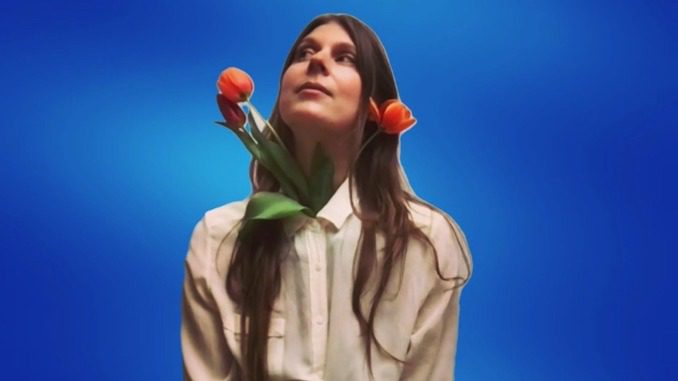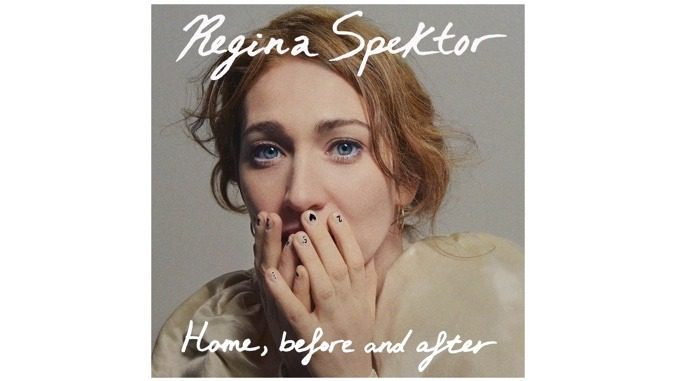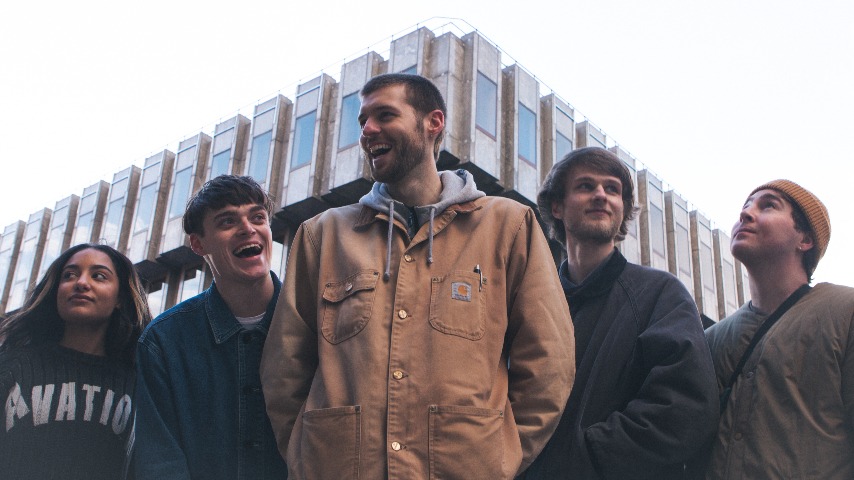Some folks drift through life, oblivious to all the ephemeral beauty that surrounds them. This is not a crime, of course—they’re just missing that internal childlike-wonder chip that keeps their senses, whether audio, visual, olfactory or otherwise, on high alert. And some are quite happy that way. They buy the latest Top 10 CD every couple of months at Target, and that’s all the stimulus they actually require, no added input necessary. Then there are rare breeds like Toronto musician Lydia Ainsworth, an eagle-eyed aesthete who is always scanning the horizon for gorgeous potential sources of inspiration. And four albums into her impressive career, she doesn’t miss a trick.
The last conversation Ainsworth had with this writer was four years ago, ostensibly to discuss her ethereal second album, Darling of the Afterglow, and stunning surreal videos that her sister Abby had directed for several songs. But it quickly veered off course, the way great conversations can, as she caromed through some of the album’s varied inspirations, like artist Rene Magritte—citing the disparity between his playful enigmatic signature This not a Pipe and a more sobering The Menaced Assassin—as well as Stanley Kubrick’s underrated Tom Cruise/Nicole Kidman masterpiece Eyes Wide Shut, and French author Henri Bergson’s heady 1896 treatise Matter and Memory, subtitled Essay on the relation of body and spirit. Phoning to discuss her adventurous new fourth effort, Sparkles & Debris, she remembers almost all of that talk, but one detail stands out: “You turned me on to John Wick,” she says at the outset. “And I have to thank you.”
It may not be easy to keep up with the brainy Ainsworth. But it’s fun—and truly rewardin—to try. Be prepared—she’s not like anyone you’ve ever heard. With a majestic voice that’s simultaneously as operatically precise as Annie Haslam’s, as folk-seasoned as Sandy Denny’s, and as lush and mystical as Enya’s—with just a pinch of suggestive goth—she pens oblique, keyboard-based pop songs that exist in their own idiosyncratic world. The opening “Parade,” for instance, is off-kilter, stroll-paced pop, her voice insinuating itself into rich, evocative lines like “Underneath the velvet sky I’ve lost the key again,” and you may not have any idea what it means. But it just feels right, as does a bouncy Chic-echoing “Good Times,” a sinister “Amaryllis,” the rhapsodic “Forever” and a cathartic “Cake,” in which her apparent anger towards an ex rises to a crescendo: “You’d best believe you won’t be touching me ever again.” Additionally. her somber 2015 piano rendition of Chris Isaak’s “Wicked Game” framed the already-forlorn original in such a dark new flickering light that it felt like a scene out of Fritz Lang’’s Metropolis—you can’t squirm free from its funereal grip, and you won’t be forgetting it anytime soon.
Ainsworth, in general, is unforgettable, as well. With her more experimental 2014 debut Right From Real, she carved a cultish niche for herself that’s heading in a lofty, Kate Bush-impressive direction. Here’s what she had to say this time.
Paste: The first, most important pandemic-era question—did you see Eurovision Song Contest—The Story of Fire Saga last year on Netflix, and how much did you love it?
Lydia Ainsworth: Yes! And that came at a very key moment, when we really needed to be cheered up. It was the perfect balance of silliness and optimism, optimism for playing shows in the future. It came at the perfect moment, that film. And that’s one of my goals when the pandemic is over (spoiler alert)—I’m getting that giant hamster wheel! But yeah, it is a very special film.
Paste: Do you ever wonder why some people, like yourself, are simply born more curious than most?
Ainsworth: I come from Toronto, but then I also moved to New York. So I think it’s also nature and nurture. And I was very lucky. I got to study cello when I went to a public school and they just gave me an instrument to play. Which is no longer happening because of all the cutbacks in school programs. So that was reason number one—I was really lucky. And then I went to an arts high school, where I was surrounded by kids who all had an interest in the arts, and so my friends there helped guide me, as well. And also, my parents are artists, so that was pretty helpful, too. But yeah—I wonder if I would have found it on my own. I’d like to think so, but I dunno. I think there were a lot of lucky circumstances involved, too.
Paste: Looking back on that upbringing, what were some sonic or visual turning points for you?
Ainsworth: Well, some of my early memories are … for my bat mitzvah, I got a six-CD-player boombox, so that was amazing. And I just spent hours in my room, going from CD to CD, and it was all different types of music, from Stevie Wonder and The Beatles to Joni Mitchell and Bjork. So I think Bjork was one of my first influences, where I heard electronic and orchestral and her amazing voice. But then I equally just adored pop music, as well as all these classics. So that’s what I was just lapping up—anything I could get my hands on. And also, as a cellist, a teacher at school sent me this video of Jacqueline du Pre, playing the Elgar concerto, I think when she was around my age at the time—when it was filmed, she was a young teenager. And that, to me, was absolutely inspiring, and that specific piece of music—the Elgar concerto—is just mind-blowing. And sitting in the orchestra, I wasn’t a great cellist, and I didn’t have the right technique. But I played in the orchestra and I got to sit at the back and take in everything that was going on and just absorb all this music that we were playing. And I just knew that I wanted to be writing music for instrumentalists, so that was a huge turning point for me, too. And then I started writing for my friends to play these small-ensemble-type pieces, and then I continued starting to write music for filmmakers, and then I started writing film scores. So that was my first foray into music as a job. And then I started performing when I went to New York to study film scoring. And I also started songwriting then, after a friend had invited me to play some of the film cues from his movie. He said he was having this afterparty and asked if I wanted to play something live. So I got a little orchestra together, but I didn’t have any lyrics—it was all just vocalizations. I was using my voice, but without lyrics. So then I wrote a few songs and the rest is history—I really fell in love with that whole side of music, just fell in love with songwriting.
Paste: But at some point you probably came to understand that you think visually, right?
Ainsworth: Yeah. Paintings and movies. I think they really inspire me, visually, for sure. And my grandmother was a painter. She was kind of from the Impressionist school. And I’ve been very inspired by this painter Leonora Carrington.
Paste:
The Hearing Trumpet!
Ainsworth: Oh, I have that book right in front of me right now! I love that! And I just ordered it because I love her. But I became obsessed with her paintings first. Every time I go on tour, I like to go to the art galleries of each city. And where was I? I dunno—it was just a strange part of America, but there was this amazing collection of Surrealist art, and they had her—all these paintings from Leonora Carrington. So I just dialed into all of her works, and then I found out—like you know—that she’s also a writer, so I just started this book, and it’s like Alice in Wonderland for 80-year-olds—it’s pretty wild. And of course, photography is important, too—I think Diane Arbus is amazing. But that is a pleasure that I have missed, going to galleries and just standing in front of a piece of artwork. That’s something I really miss.
Paste: I just saw a similar scene in Showtime’s recent Australian mystery series The Gloaming— a character is just sitting in an art museum, transfixed by this truly creepy painting of ravens hungrily encircling a ewe and her frail lamb. I want that painting.
Ainsworth: That just reminded me of this documentary—and now I have a suggestion for you— called The Painter and the Thief, and the way you described that painting reminds me of this painting that the documentary opens with. It’s about this painting that’s stolen, and basically you can’t even believe that it’s a documentary because of what happens. But it’s this epic, far-fetched, incredible story, and it was on Vimeo for awhile. It’s very good, and very moving, and a very healing documentary about two people, a painter and a thief, and she befriends the thief of her painting. So it’s about their healing journey, and it’s quite amazing.
Paste: Speaking of film, your Tokyo-filmed clip for “Cake” is quite curious, with you flitting through town with Seventh Seal-ish figure of Death.
Ainsworth: Ha! Yeah! And I actually don’t even know who that is in the cloak—the figure of Death! The person who plays him in the video is a friend of the director [Takeshi Suga] who sent the clip, and I’d just met the director the day before in a small town, Matsumoto, just outside of Tokyo, where I had just played a show. And I had one night left in Tokyo—I’d been on tour for 10 days, and this was a few years ago, prior to the pandemic. And I told him, “I’m in town for one more night—I’d love to shoot a video amid all the sights of downtown Tokyo.” And he just took me to all his favorite spots with his friend, who was wearing the mask and the cloak, and he came up with this little narrative. But it was for another song of mine that didn’t feel right, so we didn’t know what to do with it, so we kind of ended that night with a, “Well, that was fun, but I don’t know what I’m gonna do with this.” So I recently messaged him, saying, “Do you still have that footage? I can’t shoot anything right now because we’re in a pandemic, so it’d be great to see what I could do with it.” So he sent it to me, and I immediately thought, “Oh, this goes with ‘’Cake’!” And then I edited it in iMovie, and it turned out pretty well. And I had it color-corrected, as well, so we could bring out all the vibrancy of Tokyo at night.
Paste: Is your sister Abby still directing videos?
Ainsworth: Yeah, she is. But we actually haven’t been able to shoot together because of the lockdown. So we might do one for the next song, but I’m not sure yet. I still haven’t had my vaccination. We’re a bit behind you guys up here in Canada.
Paste: When we talked for 2017’s Darling of the Afterglow, you were taking sculpture and drawing classes to help your process. Did you try anything new for this one?
Ainsworth: Since then I took up dance. And I was taking a lot of dance classes. I love putting myself In situations where I do not know what I’m doing, and where I can also learn a skill. I like feeling just completely like a fool—I really like that feeling. Like, “I’m here to learn something, but I have no idea what I’m doing!” And I became obsessed with dance classes, so I was taking tons of jazz and ballet and modern. And that’s something else I’ve really been missing during this pandemic—I was going a few times a week, but it really helped with freeing my mind when I was composing. It lets you get in that state of … back before I learned anything in school about music, that feeling of a clean slate. So I like learning new skills like that. It switches your brain into remembering that feeling of being open to all inspiration, and just being open to trying new things, as well.
Paste: I like the a-ha-ish, faux-Rotoscope clip for “Parade.” It’s got this wistful, you-can-never-go-home-again quality, as you walk through what looks like your hometown while you’re maybe back there on Christmas vacation.
Ainsworth: Yeah, exactly. And that is where I grew up, or close to where I grew up, and it’s where I’ve been for the pandemic. And I actually had a friend of mine say the same kind of thing— that it has that nostalgic quality about it. And it was born out of necessity, but it’s nice that it has this nostalgic quality about it. And as I said with “Cake,” I learned how to edit in iMovie, and it’s just so basic. I just filmed it on a camera phone, and then I put it in iMovie with just a black-and-white effect, and then I added the colors after. And I hired a colorist to add in those colors—ones that would cycle through, and also draw in, the colors of my album cover. And that album cover is by a friend of mine, Sara Cwynar, and she’s a fantastic fine artist. And that’s how she works—a lot of her work is collage, so I just called her up in lockdown and said, “I can’t go anywhere, I can’t shoot anything, so would you be down to do this?” And she created this amazing cover of me—I took a picture of myself and she put it in the center and built around it.
Paste: We didn’t get to talk on your last album, Phantom Forest. What was the theme?
Ainsworth: I was personifying Mother Nature. So it was about the destruction of nature, and her rage. And we have brought about our own extinction—it’s terrible, but true. And it’s terrifying. Someone told me a quote—and it’s not a positive one—that some famous writer said. And I’m sorry, I don’t remember who he was, but he basically said that the world we’re living in is like a clown after the performance of a play, telling the audience, “There’s a fire! There’s a fire!” And there is a fire, and it’s burning, but they’re all just laughing.
Paste: So what’s the general gist of Sparkles & Debris, then?
Ainsworth: Well, there’s a lot of longing—I think that’s the major theme. Whether it’s longing in love, or longing to be free from oppression, or longing for the spark of inspiration, or the muse of inspiration, to make a visit. And then I have a lot of spell songs that are in there, as well, to kind of help with my listeners’ longing. If any of my listeners want a love charm or some kind of spell for creating a better life for themselves, I have these interspersed throughout the album. So it’s kind of a magical album. And I’m not Wiccan, but I believe in the power of spells. And a lot of fans have come up to me, and they bring me spells, and I was given a few spell books. And I tried a few of ‘em, and some of ‘em actually worked, so I put them into this album. And the title Sparkles & Debris is kind of my prescription for life itself—it’s like, the good and the bad, rainbows and tornadoes, and smiling through the tears. That’s what that title means to me, and the album kind of encompasses my experiences in life and my observations. So “Love Charm”—that’s a spell. And “Halo of Fire”—they’re directions, almost like a recipe. And “Amaryllis,” too—a song for when you’re feeling stuck and need to grow in new directions, like the amaryllis flower. It’s about planting the bulb of an amaryllis, and there are actually directions in the lyric.
Paste: Have you ever experienced anything otherworldly? Beyond your ken?
Ainsworth: I think so, yeah. And I believe in all that—I believe in everything. But I had my appendix out, and that, for me, was a near-death experience. And I remember having the most vivid dreams that night, and I think I actually did have an out-of-body experience. And it was pretty inspiring, actually, and just one of those things that you never forget. There was this great quote from Nick Cave I read, where he was talking about grief having to do with the death of his son. And he said, “All manner of madness exists—ghosts and spirits and dream visitations, and everything else that we, in our anguish, will into existence. These are precious gifts that are as real as you need them to be. They are the spirit guides that lead us out of the darkness.” So whether they’re real or not, it does not matter, you see? They are there because you will them to be.
Paste: So your ultimate advice to those hanging on your every word is?
Ainsworth: Get off the phone and find out what lights you up!




